Abstract
The specificity of the tube LAI in breast cancer was examined in a study with coded samples of PBL. In addition, 64 patients with breast cancer had their LAI reactivity monitored and correlated with their clinical status for up to 3 years after mastectomy. When patients were assayed by tube LAI, 83, 72, and 29% with Stage I, and II and III breast cancer respectively were positive. In Stage IV brest cancer, 88% of those with local recurrence and 15% of those with disseminated cancer were positive. By contrast, 3% of control subjects were LAI+. A select group of patients admitted to hospital with suspicious breast lumps that histopathologically proved to be benign breast disease (BBD) had a higher incidence of LAI+ (12%), whereas of outpatients with BBD only 2% were LAI+. Most breast cancer patients LAI reactivity became negative 2--4 months after mastectomy, even when some harboured micrometastases. LAI reactivity remained absent in those patients who remained clinically "cancer-free". In the follow-up patients, LAI activity returned about 4 months before local recurrence. LAI reactivity was observed in 7/8 patients in the coded study and 14/15 patients in the follow-up study preceding and/or at the time of local recurrence. A few patients (15%) progressed to widespread cancer without preceding positive LAI activity. The results suggest that tumour-specific immunity rapidly fades after surgery and may play no role in the rejection of micrometastases by 6 months after surgery. In addition, the present study has shown that the human hose manifests tumour-specific immunity when the cancer is small, and suggests that the early detection of human cancer would depend upon reliable methods to measure the tumour-specific immune response.
Full text
PDF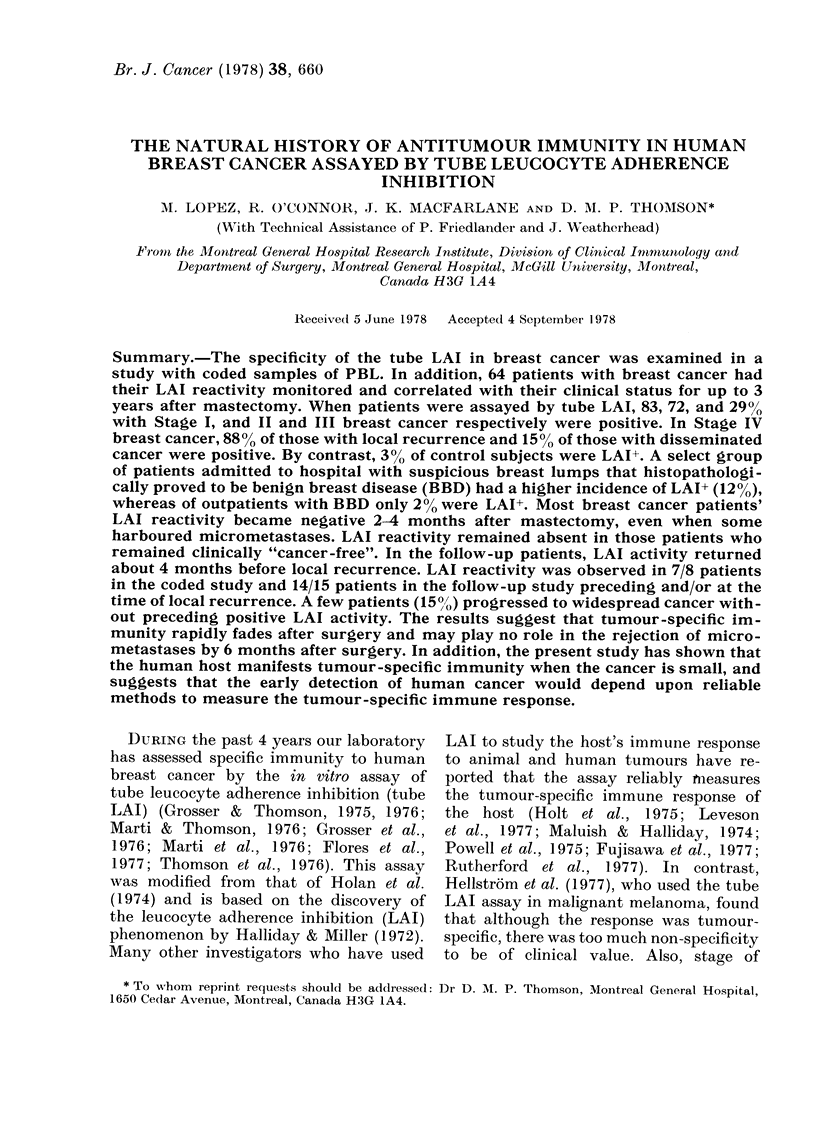
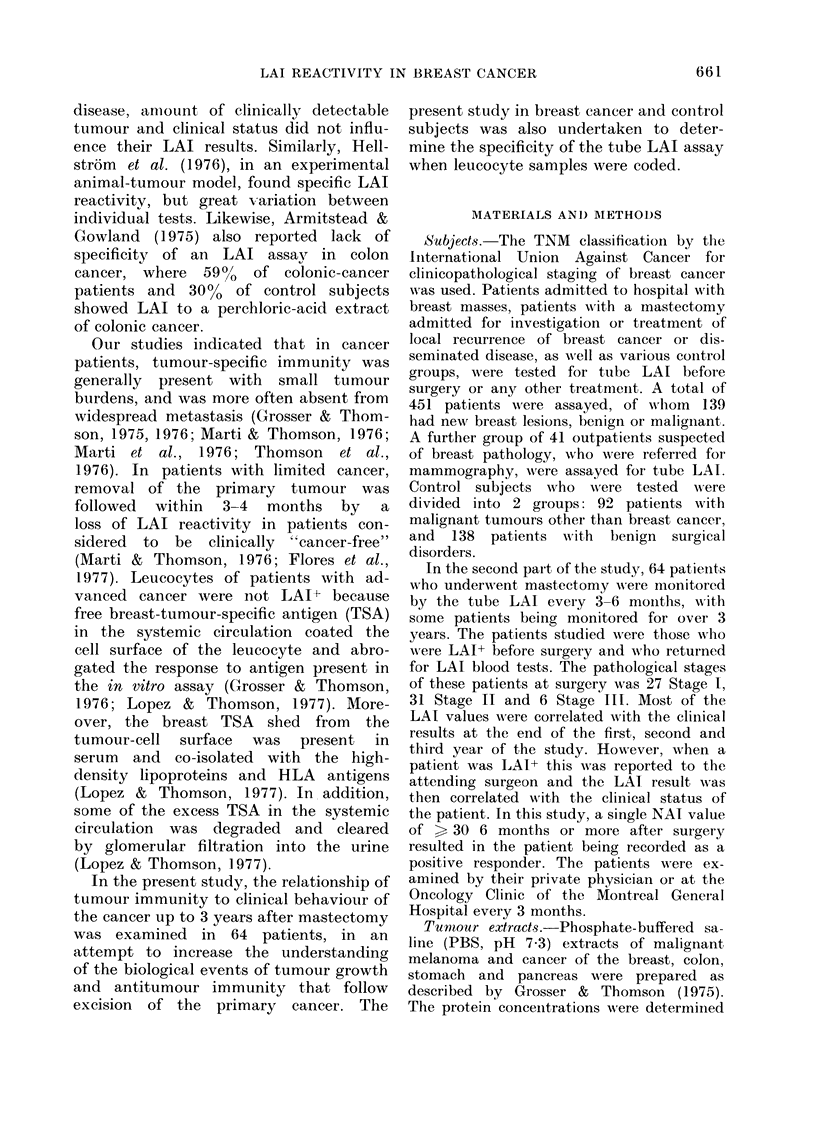
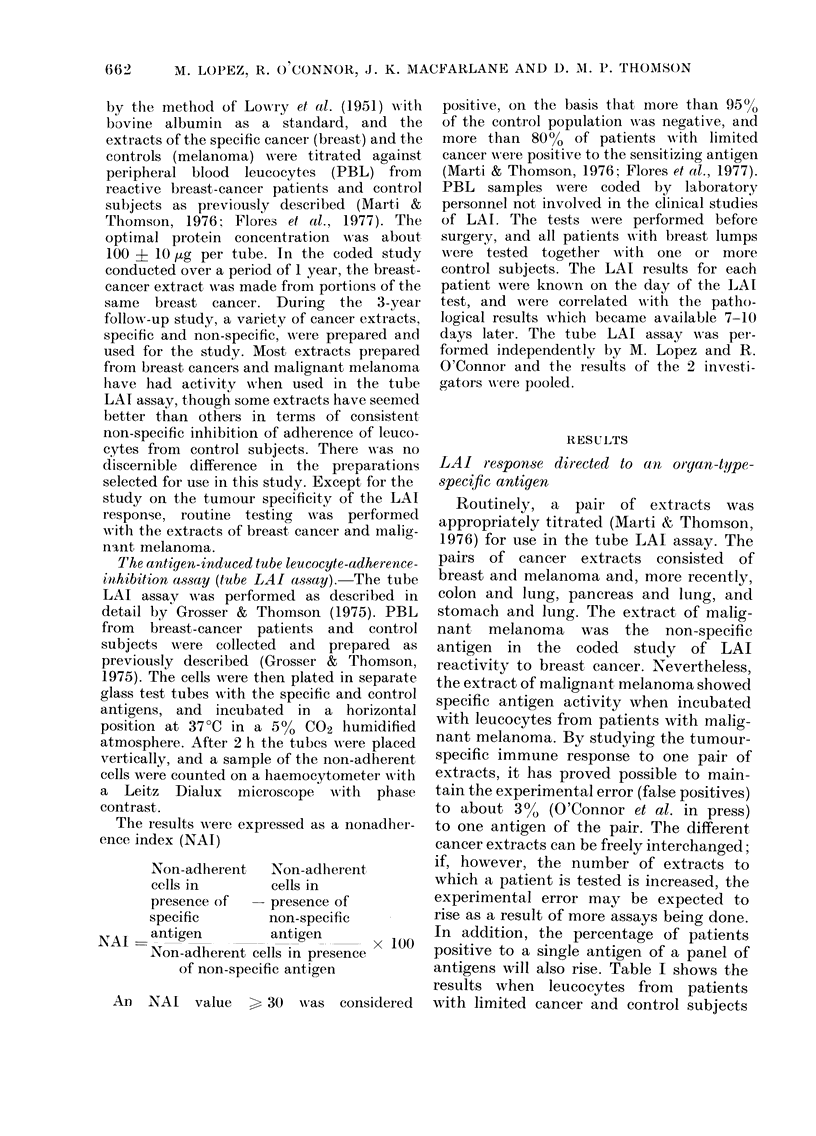
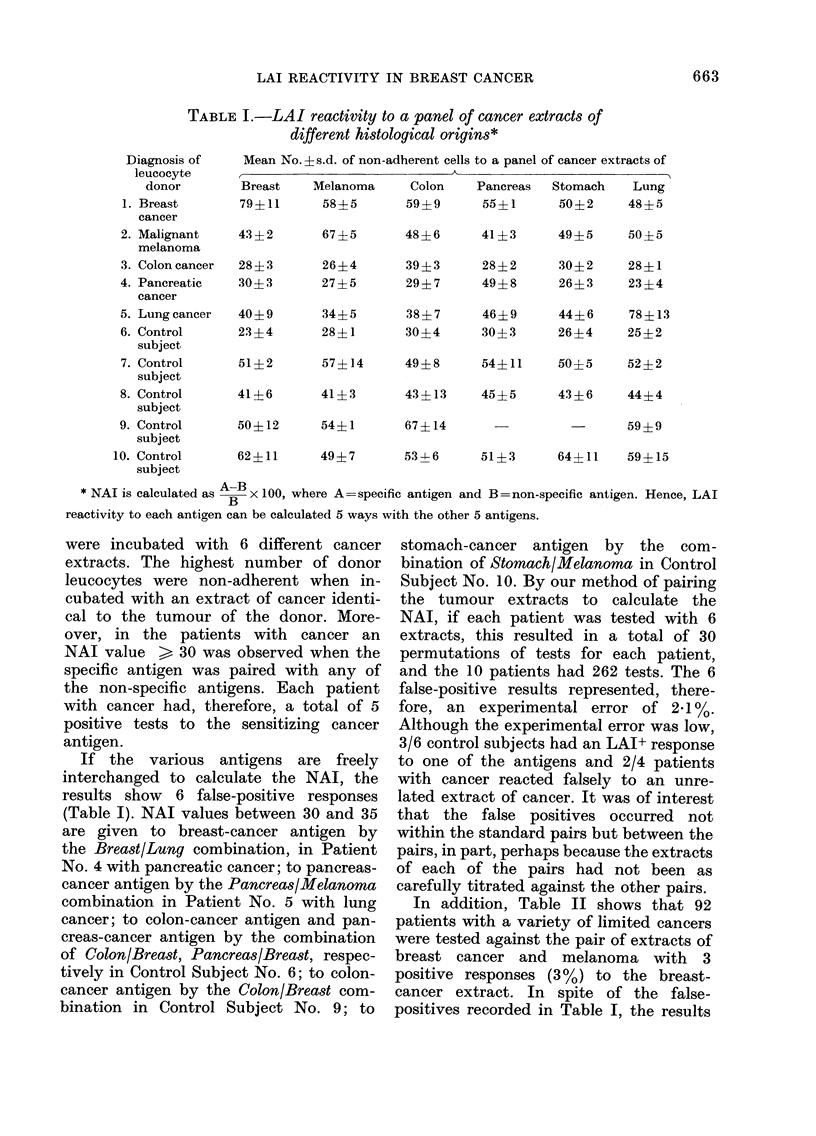
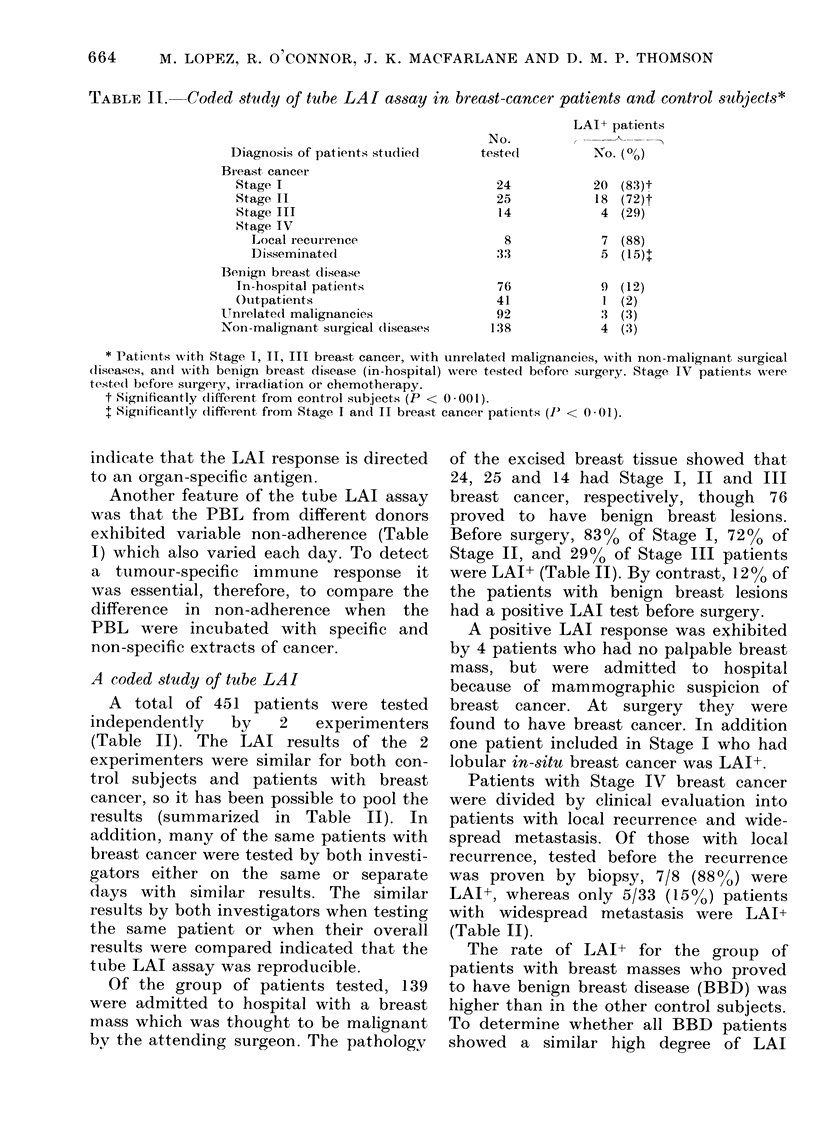
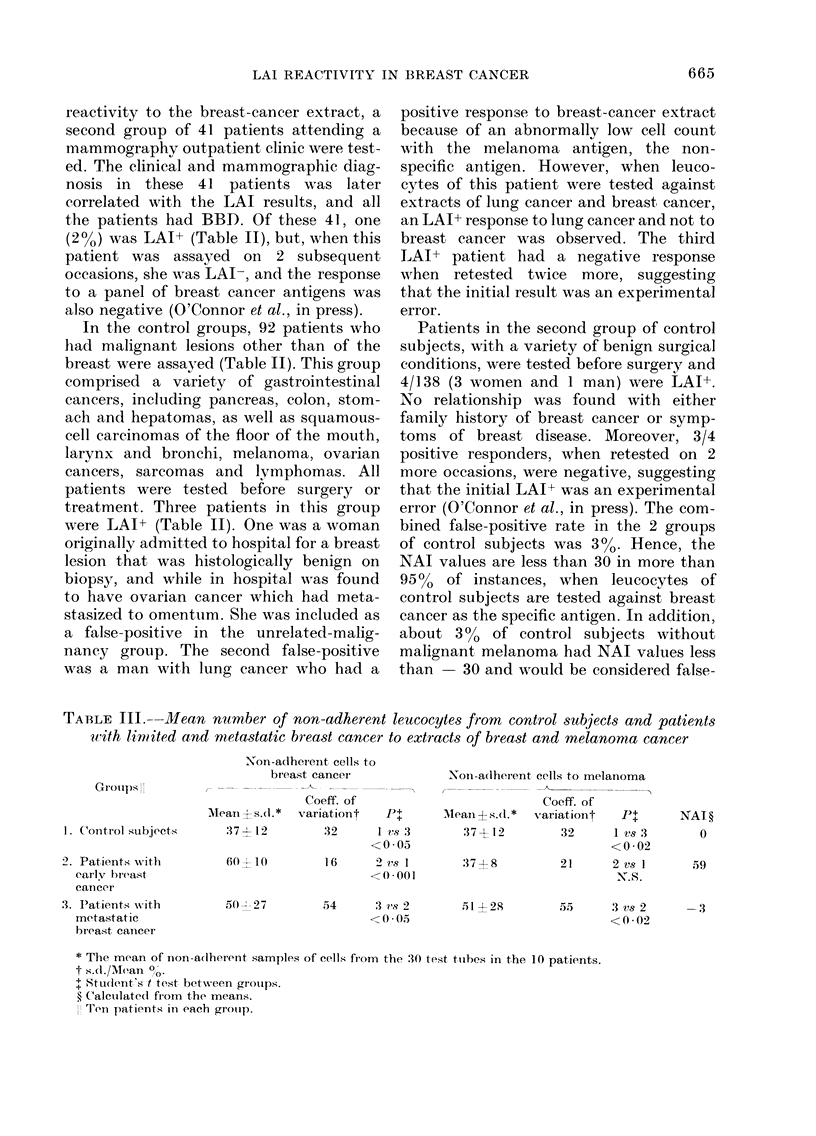
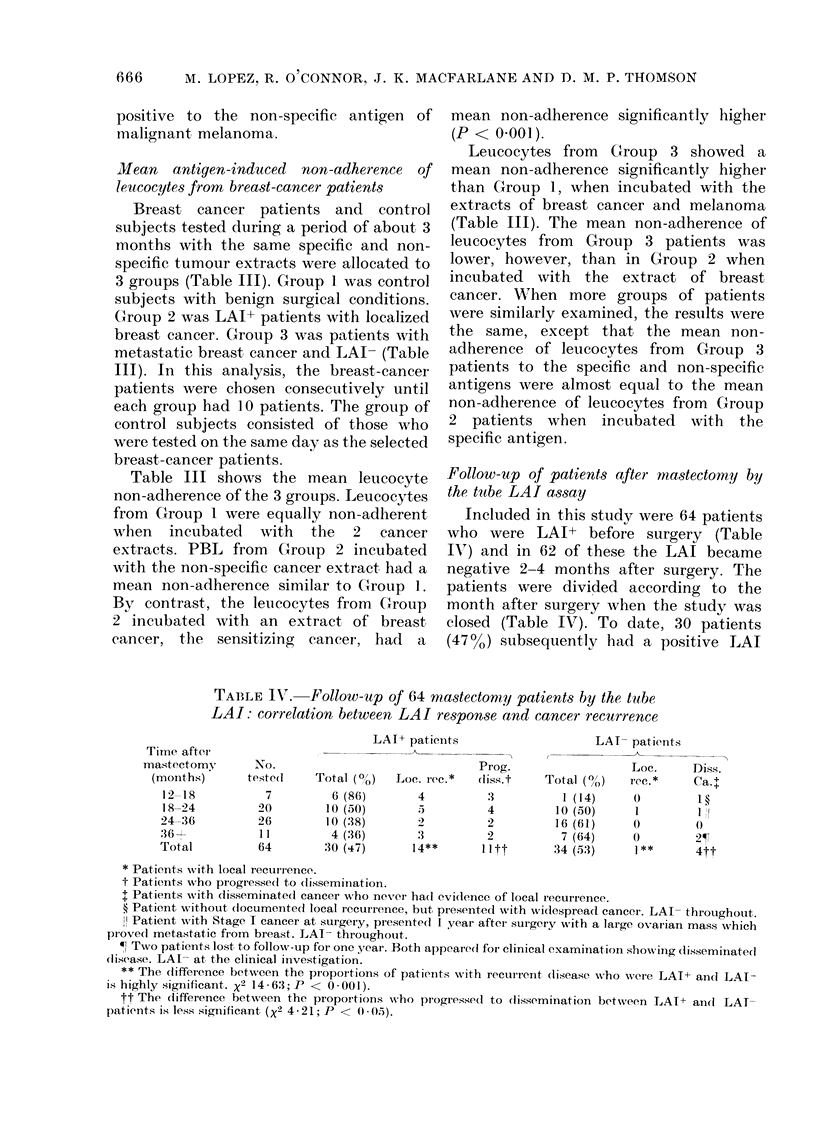
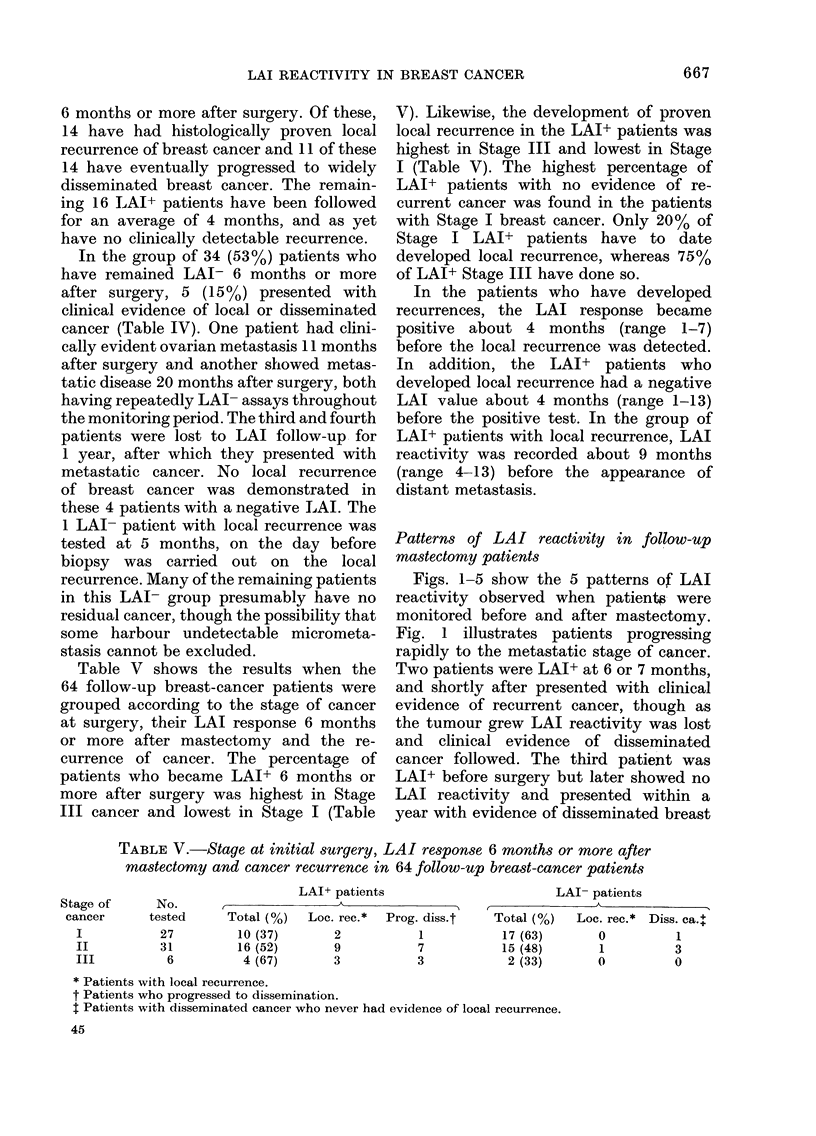
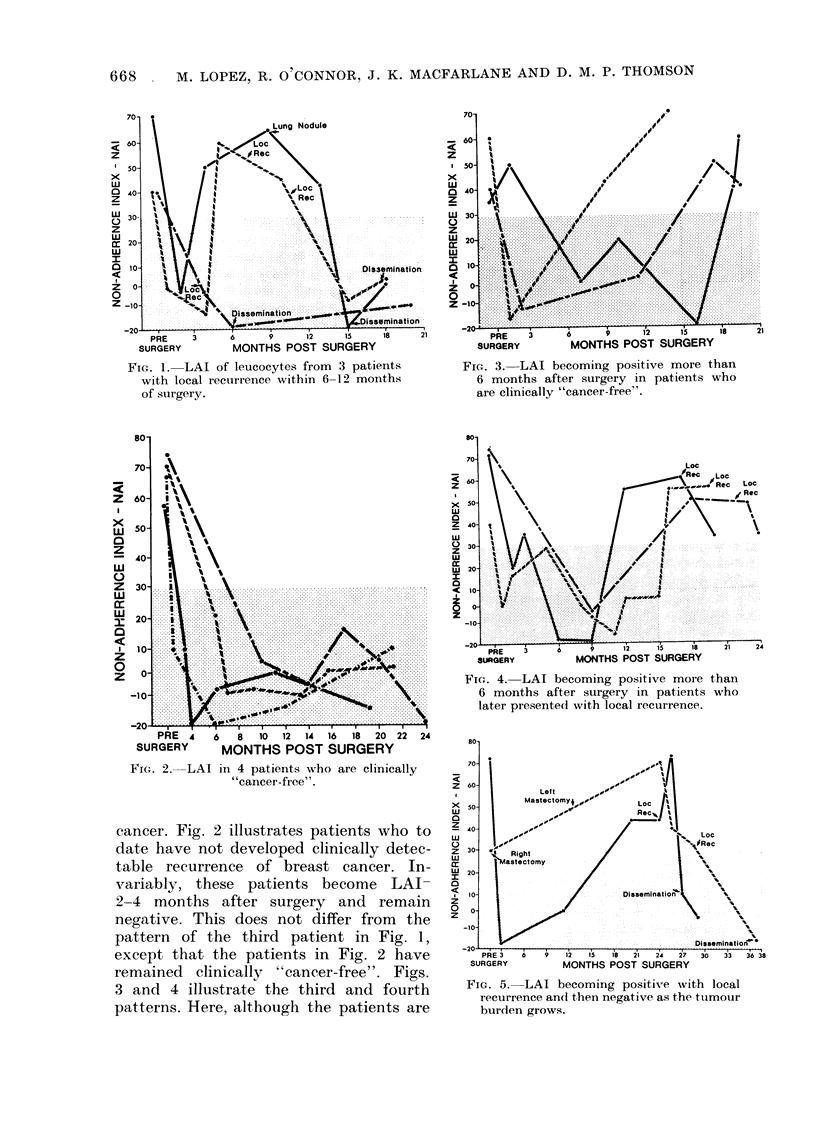
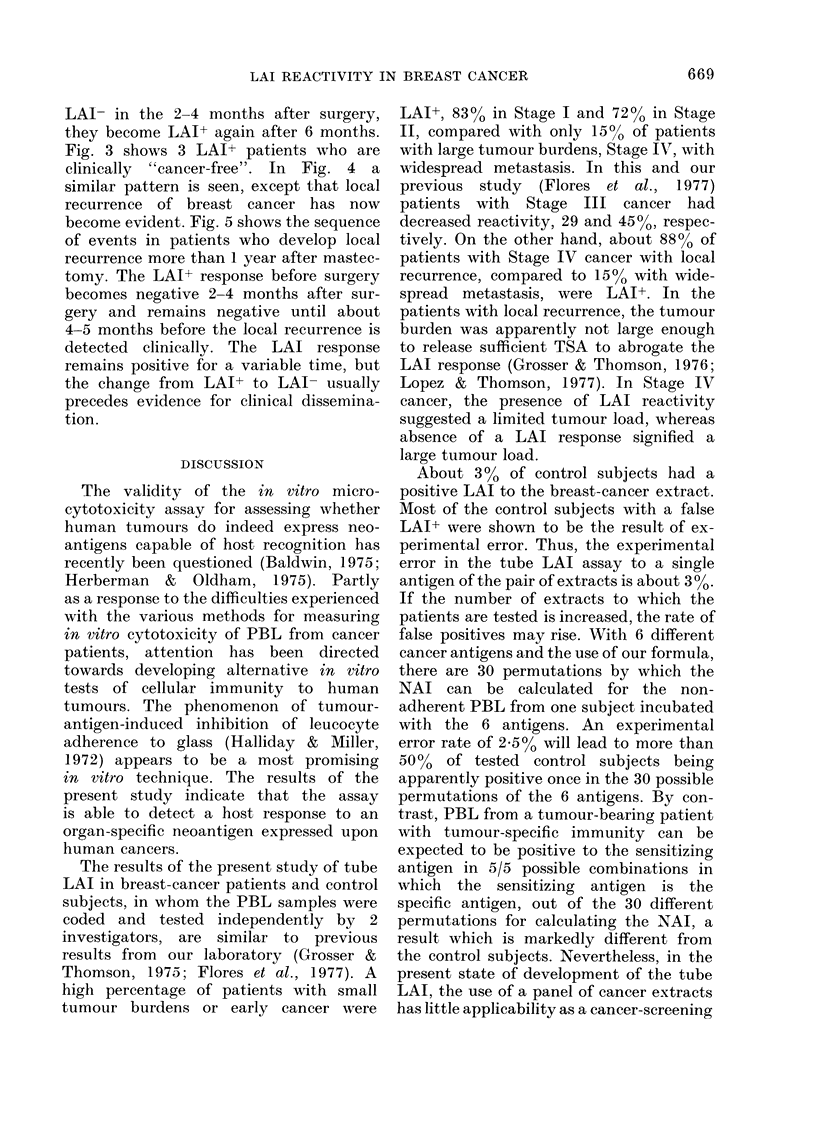
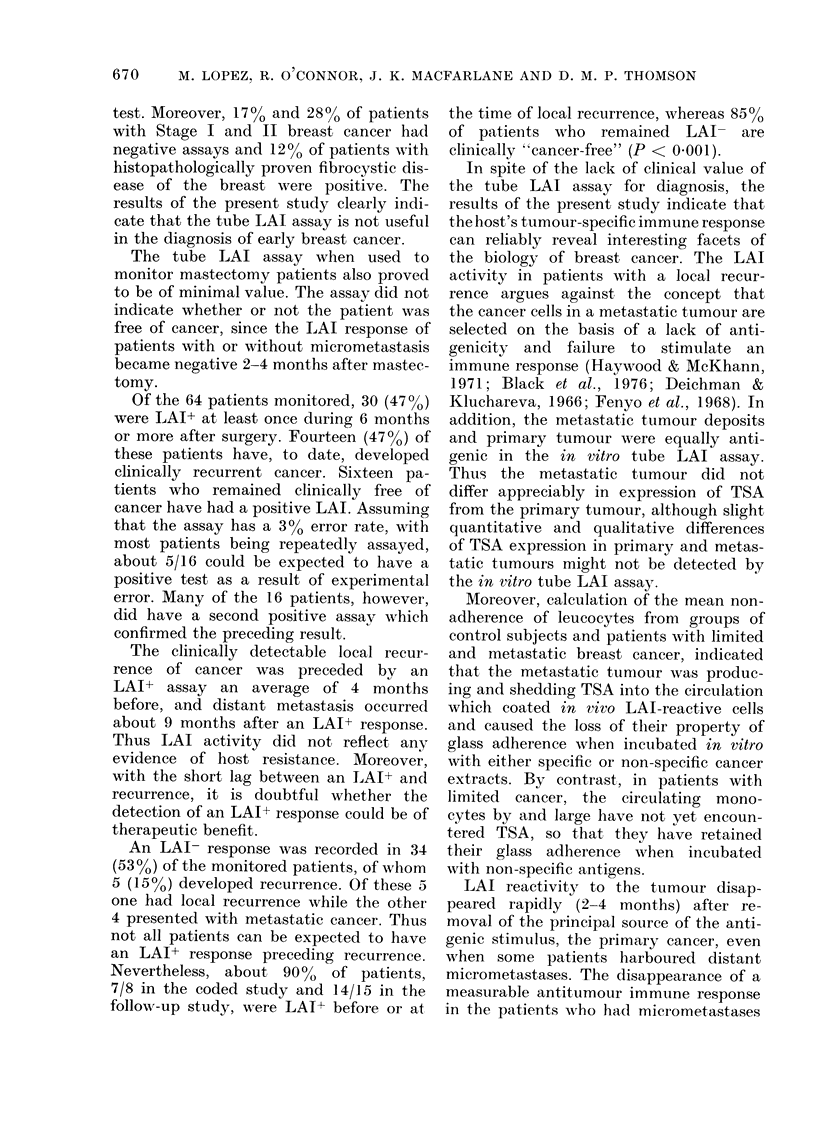
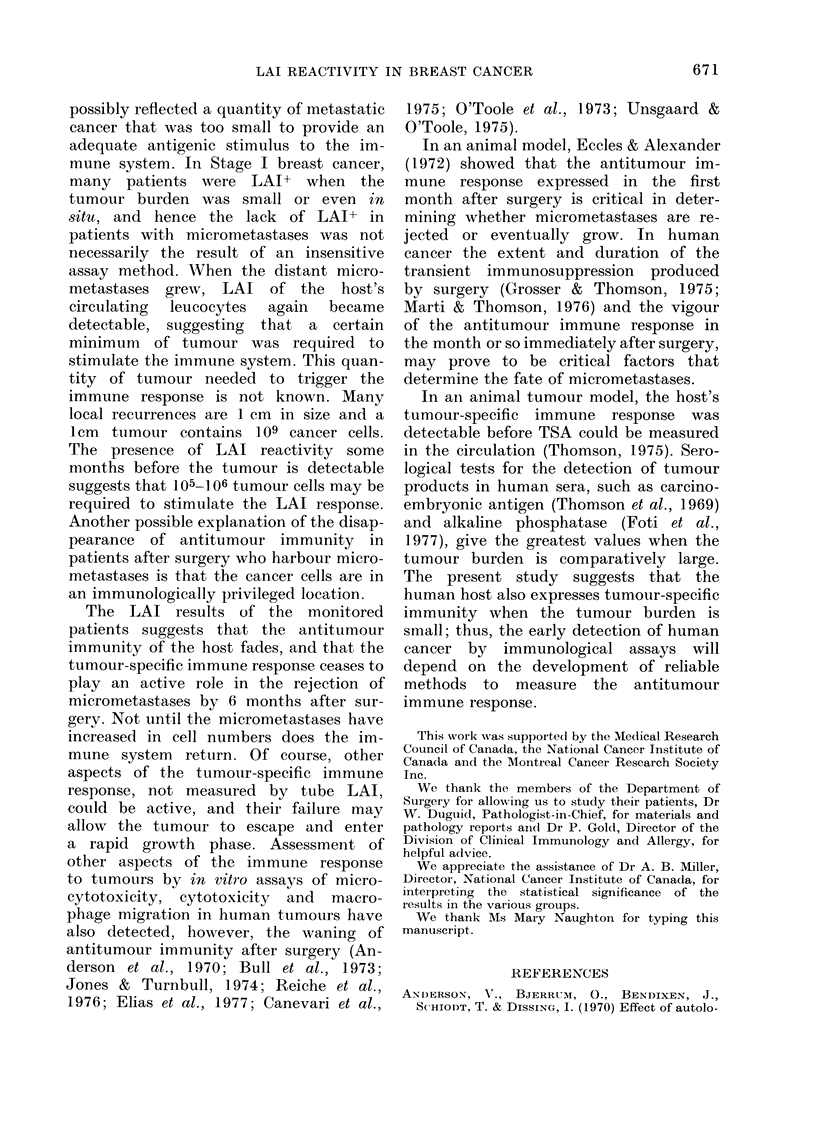
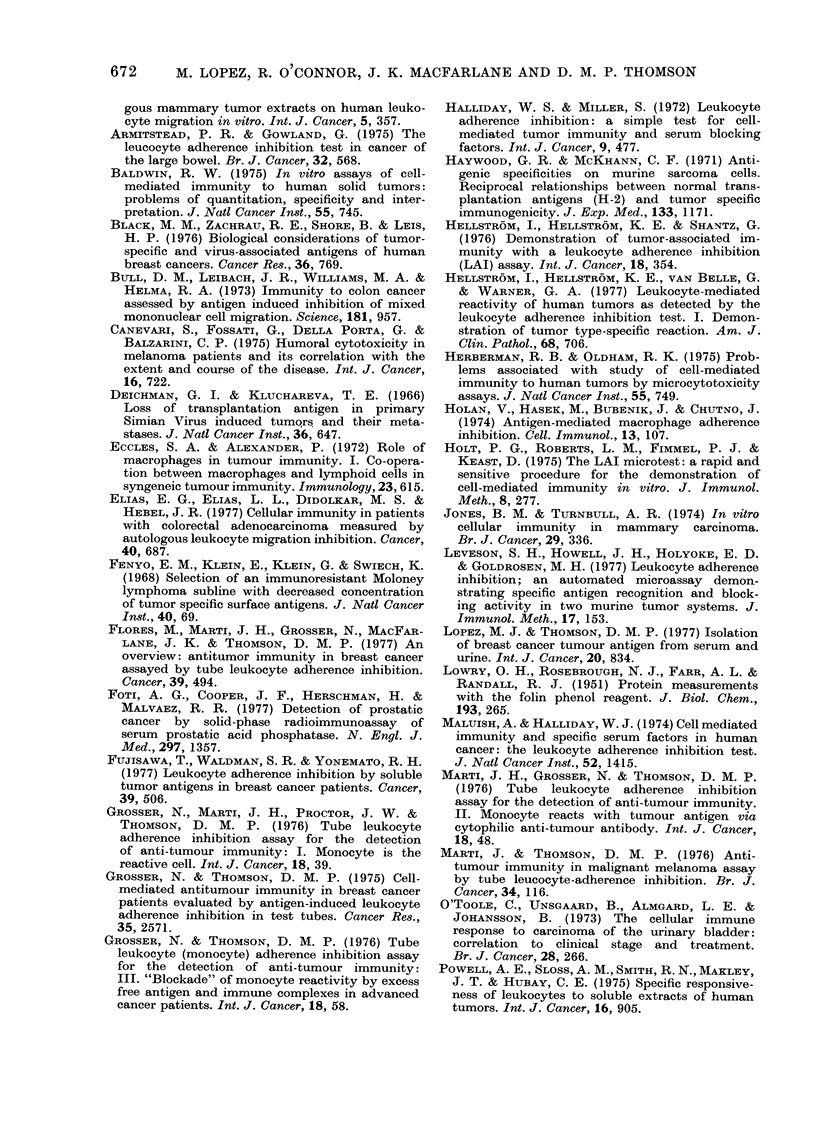
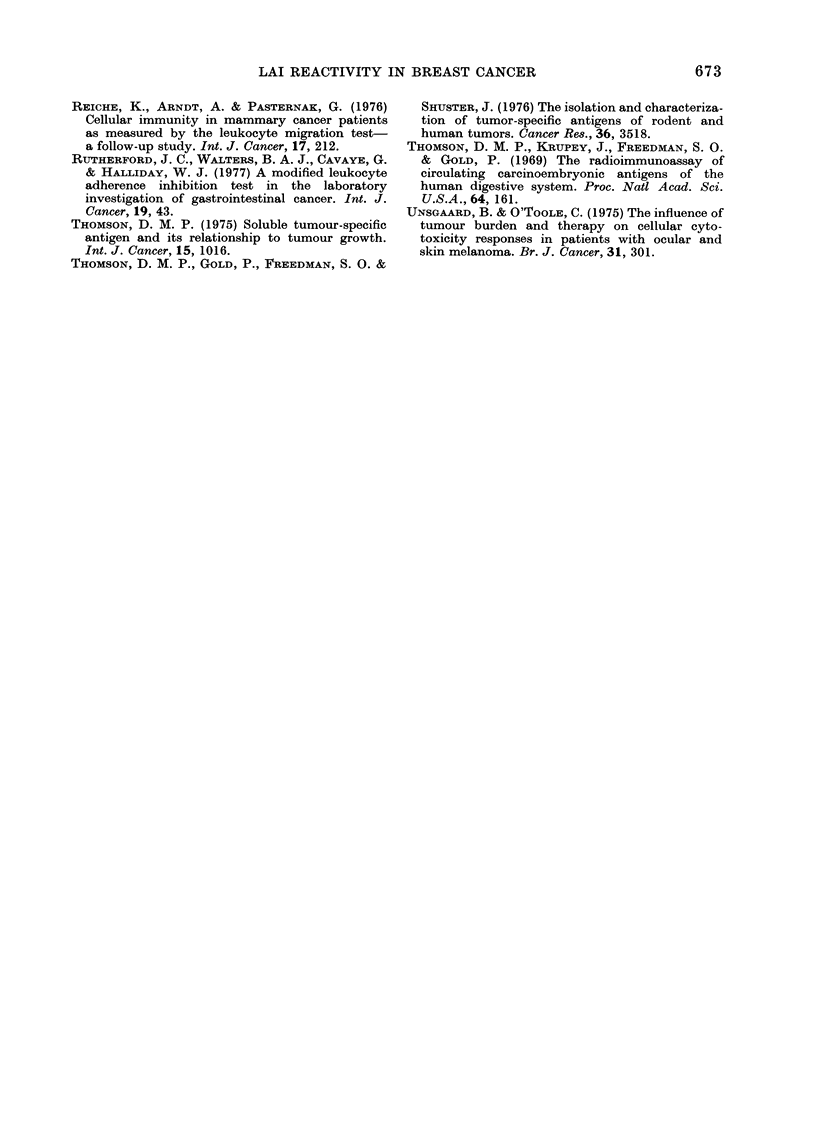
Selected References
These references are in PubMed. This may not be the complete list of references from this article.
- Andersen V., Bjerrum O., Bendixen G., Schiodt T., Dissing I. Effect of autologous mammary tumour extracts on human leukocyte migration in vitro. Int J Cancer. 1970 May 15;5(3):357–363. doi: 10.1002/ijc.2910050308. [DOI] [PubMed] [Google Scholar]
- Armitstead P. R., Gowland G. The leucocyte adherence inhibtion test in cancer of the large bowel. Br J Cancer. 1975 Nov;32(5):568–573. doi: 10.1038/bjc.1975.262. [DOI] [PMC free article] [PubMed] [Google Scholar]
- Baldwin R. W. In vitro assays of cell-mediated immunity to human solid tumors: problems of quantitation, specificity, and interpretation. J Natl Cancer Inst. 1975 Oct;55(4):745–748. doi: 10.1093/jnci/55.4.745. [DOI] [PubMed] [Google Scholar]
- Black M. M., Zachrau R. E., Shore B., Leis H. P., Jr Biological considerations of tumor-specific and virus-associated antigens of human breast cancers. Cancer Res. 1976 Feb;36(2 Pt 2):769–774. [PubMed] [Google Scholar]
- Bull D. M., Leibach J. R., Williams M. A., Helms R. A. Immunity to colon cancer assessed by antigen-induced inhibition of mixed mononuclear cell migration. Science. 1973 Sep 7;181(4103):957–959. doi: 10.1126/science.181.4103.957. [DOI] [PubMed] [Google Scholar]
- Canevari S., Fossati G., Della Porta G., Balzarini G. P. Humoral cytotoxicity in melanoma patients and its correlation with the extent and course of the disease. Int J Cancer. 1975 Nov 15;16(5):722–729. doi: 10.1002/ijc.2910160504. [DOI] [PubMed] [Google Scholar]
- Deichman G. I., Kluchareva T. E. Loss of transplantation antigen in primary simian virus 40-induced tumors and their metastases. J Natl Cancer Inst. 1966 Apr;36(4):647–655. doi: 10.1093/jnci/36.4.647. [DOI] [PubMed] [Google Scholar]
- Elias E. G., Elias L. L., Didolkar M. S., Hebel J. R. Cellular immunity in patients with colorectal adenocarcinoma measured by autologous leukocyte migration inhibition. Cancer. 1977 Aug;40(2):687–692. doi: 10.1002/1097-0142(197708)40:2<687::aid-cncr2820400215>3.0.co;2-c. [DOI] [PubMed] [Google Scholar]
- Evans R., Alexander P. Role of macrophages in tumour immunity. I. Co-operation between macrophages and lymphoid cells in syngeneic tumour immunity. Immunology. 1972 Oct;23(4):615–626. [PMC free article] [PubMed] [Google Scholar]
- Fenyö E. M., Klein E., Klein G., Swiech K. Selection of an immunoresistant Moloney lymphoma subline with decreased concentration of tumor-specific surface antigens. J Natl Cancer Inst. 1968 Jan;40(1):69–89. [PubMed] [Google Scholar]
- Flores M., Marti J. H., Grosser N., MacFarlane J. K., Thomson D. M. An overview: antitumor immunity in breast cancer assayed by tube leukocyte adherence inhibition. Cancer. 1977 Feb;39(2):494–505. doi: 10.1002/1097-0142(197702)39:2<494::aid-cncr2820390218>3.0.co;2-8. [DOI] [PubMed] [Google Scholar]
- Foti A. G., Cooper J. F., Herschman H., Malvaez R. R. Detection of prostatic cancer by solid-phase radioimmunoassay of serum prostatic acid phosphatase. N Engl J Med. 1977 Dec 22;297(25):1357–1361. doi: 10.1056/NEJM197712222972501. [DOI] [PubMed] [Google Scholar]
- Fujisawa T., Waldman S. R., Yonemoto R. H. Leukocyte adherence inhibition by soluble tumor antigens in breast cancer patients. Cancer. 1977 Feb;39(2):506–513. doi: 10.1002/1097-0142(197702)39:2<506::aid-cncr2820390219>3.0.co;2-5. [DOI] [PubMed] [Google Scholar]
- Grosser N., Marti J. H., Proctor J. W., Thomson D. M. Tube leukocyte adherence inhibition assay for the detection of anti-tumor immunity. I. Monocyte is the reactive cell. Int J Cancer. 1976 Jul 15;18(1):39–47. doi: 10.1002/ijc.2910180107. [DOI] [PubMed] [Google Scholar]
- Grosser N., Thompson D. M. Tube leukocyte (monocyte) adherence inhibition assay for the detection of anti-tumour immunity. III. "Blockade" of monocyte reactivity by excess free antigen and immune complexes in advanced cancer patients. Int J Cancer. 1976 Jul 15;18(1):58–66. doi: 10.1002/ijc.2910180109. [DOI] [PubMed] [Google Scholar]
- Grosser N., Thomson D. M. Cell-mediated antitumor immunity in breast cancer patients evaluated by antigen-induced leukocyte adherence inhibition in test tubes. Cancer Res. 1975 Sep;35(9):2571–2579. [PubMed] [Google Scholar]
- Halliday W. J., Miller S. Leukocyte adherence inhibition: a simple test for cell-mediated tumour immunity and serum blocking factors. Int J Cancer. 1972 May 15;9(3):477–483. doi: 10.1002/ijc.2910090304. [DOI] [PubMed] [Google Scholar]
- Haywood G. R., McKhann C. F. Antigenic specificities on murine sarcoma cells. Reciprocal relationship between normal transplantation antigens (H-2) and tumor-specific immunogenicity. J Exp Med. 1971 Jun 1;133(6):1171–1187. doi: 10.1084/jem.133.6.1171. [DOI] [PMC free article] [PubMed] [Google Scholar]
- Hellström I., Hellström K. E., Shantz G. Demonstration of tumor-associated immunity with a leukocyte adherence inhibition (LAI) assay. Int J Cancer. 1976 Sep 15;18(3):354–361. doi: 10.1002/ijc.2910180314. [DOI] [PubMed] [Google Scholar]
- Hellström I., Hellström K. E., van Belle G., Warner G. A. Leukocyte-mediated reactivity to human tumors as detected by the leukocyte adherence inhibition test. I. Demonstration of tumor type-specific reactions. Am J Clin Pathol. 1977 Nov;68(5 Suppl):706–714. [PubMed] [Google Scholar]
- Herberman R. B., Oldham R. K. Problems associated with study of cell-mediated immunity to human tumors by microcytotoxicity assays. J Natl Cancer Inst. 1975 Oct;55(4):749–753. doi: 10.1093/jnci/55.4.749. [DOI] [PubMed] [Google Scholar]
- Holt P. G., Roberts L. M., Fimmel P. J., Keast D. The L.A.I. microtest: a rapid and sensitive precedure for the demonstration of cell-mediated immunity in vitro. J Immunol Methods. 1975 Sep;8(3):277–288. doi: 10.1016/0022-1759(75)90122-2. [DOI] [PubMed] [Google Scholar]
- Holán V., Hasek M., Bubeník J., Chutná J. Antigen-mediated macrophage adherence inhibition. Cell Immunol. 1974 Jul;13(1):107–116. doi: 10.1016/0008-8749(74)90231-7. [DOI] [PubMed] [Google Scholar]
- LOWRY O. H., ROSEBROUGH N. J., FARR A. L., RANDALL R. J. Protein measurement with the Folin phenol reagent. J Biol Chem. 1951 Nov;193(1):265–275. [PubMed] [Google Scholar]
- Leveson S. H., Howell J. H., Holyoke E. D., Goldrosen M. H. Leukocyte adherence inhibition: an automated microassay demonstrating specific antigen recognition and blocking activity in two murine tumor systems. J Immunol Methods. 1977;17(1-2):153–162. doi: 10.1016/0022-1759(77)90086-2. [DOI] [PubMed] [Google Scholar]
- Lopez M. J., Thomson D. M. Isolation of breast cancer tumour antigen from serum and urine. Int J Cancer. 1977 Dec 15;20(6):834–848. doi: 10.1002/ijc.2910200604. [DOI] [PubMed] [Google Scholar]
- Maluish A., Halliday W. J. Cell-mediated immunity and specific serum factors in human cancer: the leukocyte adherence inhibition test. J Natl Cancer Inst. 1974 May;52(5):1415–1420. doi: 10.1093/jnci/52.5.1415. [DOI] [PubMed] [Google Scholar]
- Marti J. H., Grosser N., Thomson D. M. Tube leukocyte adherence inhibition assay for the detection of anti-tumour immunity. II. Monocyte reacts with tumour antigen via cytophilic anti-tumour antibody. Int J Cancer. 1976 Jul 15;18(1):48–57. doi: 10.1002/ijc.2910180108. [DOI] [PubMed] [Google Scholar]
- Marti J. H., Thomson D. M. Anti-tumour immunity in malignant melanoma assay by tube leucocyte adherence inhibition. Br J Cancer. 1976 Aug;34(2):116–133. doi: 10.1038/bjc.1976.134. [DOI] [PMC free article] [PubMed] [Google Scholar]
- O'Toole C., Unsgaard B., Almgård L. E., Johansson B. The cellular immune response to carcinoma of the urinary bladder: correlation to clinical stage and treatment. Br J Cancer Suppl. 1973 Aug;1:266–275. [PMC free article] [PubMed] [Google Scholar]
- Powell A. E., Sloss A. M., Smith R. N., Makley J. T., Hubay C. A. Specific responsiveness of leukocytes to soluble extracts of human tumors. Int J Cancer. 1975 Dec 15;16(6):905–913. doi: 10.1002/ijc.2910160604. [DOI] [PubMed] [Google Scholar]
- Rieche K., Arndt A., Pasternak G. Cellular immunity in mammary cancer patients as measured by the leukocyte migration test (LMT). A follow-up study. Int J Cancer. 1976 Feb 15;17(2):212–218. doi: 10.1002/ijc.2910170210. [DOI] [PubMed] [Google Scholar]
- Rutherford J. C., Walters B. A., Cavaye G., Halliday W. J. A modified leukocyte adherence inhibition test in the laboratory investigation of gastrointestinal cancer. Int J Cancer. 1977 Jan;19(1):43–48. doi: 10.1002/ijc.2910190107. [DOI] [PubMed] [Google Scholar]
- Thomson D. M., Gold P., Freedman S. O., Shuster J. The isolation and characterization of tumor-specific antigens of rodent and human tumors. Cancer Res. 1976 Sep;36(9 Pt 2):3518–3525. [PubMed] [Google Scholar]
- Thomson D. M., Krupey J., Freedman S. O., Gold P. The radioimmunoassay of circulating carcinoembryonic antigen of the human digestive system. Proc Natl Acad Sci U S A. 1969 Sep;64(1):161–167. doi: 10.1073/pnas.64.1.161. [DOI] [PMC free article] [PubMed] [Google Scholar]
- Thomson D. M. Soluble tumour-specific antigen and its relationship to tumour growth. Int J Cancer. 1975 Jun 15;15(6):1016–1029. doi: 10.1002/ijc.2910150619. [DOI] [PubMed] [Google Scholar]
- Unsgaard B., O'Toole C. The influence of tumour burden and therapy on cellular cytotoxicity responses in patients with ocular and skin melanoma. Br J Cancer. 1975 Mar;31(3):301–316. doi: 10.1038/bjc.1975.65. [DOI] [PMC free article] [PubMed] [Google Scholar]


